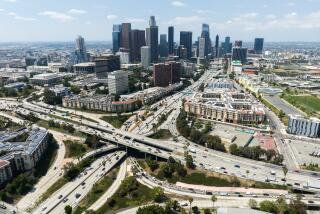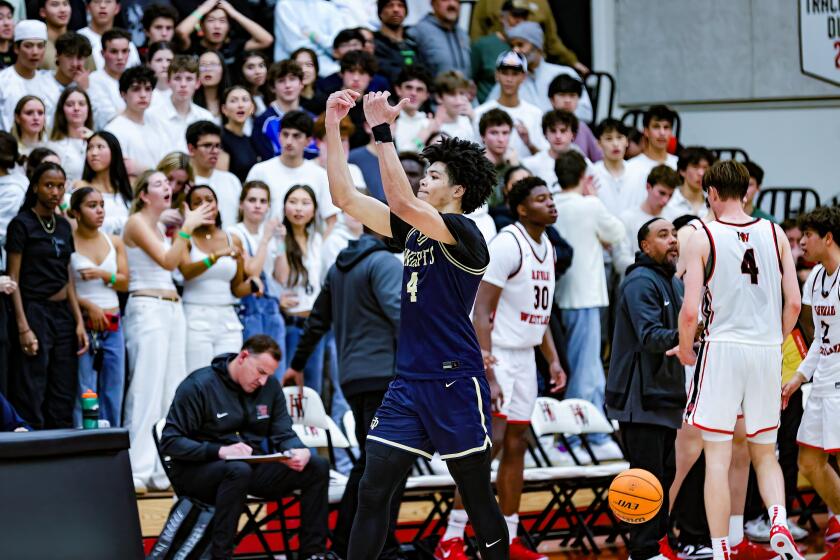Coliseum Neighbors Get a Bad Rap
- Share via
Los Angeles City Councilman Mark Ridley-Thomas has launched a one-man crusade to get the National Football League to return to the Los Angeles Coliseum.
NFL team owners are reported to be hostile to the Coliseum as an L.A. venue, so Ridley-Thomas seemed to be barking up the wrong tree. But to the surprise of sports insiders, the councilman seems to be making some headway. He has the support of the mayor and the financial muscle of Edward Roski Jr. and Philip Anschutz, the owners of the Kings.
At last week’s meeting of NFL owners in San Diego, Baltimore Raven owner Art Modell spoke disparagingly about the neighborhood surrounding the Coliseum and, despite the 32-year passage of time, referred to the 1965 Watts riot as a reason to avoid the place. He has since apologized, but what about the perception that the neighborhood surrounding the Coliseum is a boiling caldron of crime and violence?
Unlike Modell, who apparently has only experienced the neighborhood from the owners’ box at the Coliseum, in 1965 I lived at the intersection of 41st and Figueroa streets, literally a stone’s throw away. Since then, the area has undergone a great deal of change. Like much of urban L.A., it has experienced economic underdevelopment, job loss and neglect that reflected the flight of the manufacturing sector during the 1960s and ‘70s. The area took some hard hits during the 1992 riots and has struggled to recover. But the comments made about the area by Modell and other NFL owners are troubling and, taken at face value, slander an entire community.
Along Martin Luther King Boulevard west of the Harbor Freeway lies a working-class community that encompasses the Coliseum and the Sports Arena where the Clippers and USC’s basketball team play. The housing is a mix of 1930s-era homes and contemporary apartments. Throughout the area are signs that post-riot development efforts have paid off in the form of new apartment complexes and social service centers. A new Islamic mosque sits at the intersection of Exposition Boulevard and Vermont Avenue. Down the block is the L.A. Child Guidance Center. At Vermont and King a shopping center bustles with activity, and a few blocks away lies Manual Arts High School. In casual discussions with residents, people seemed optimistic about their neighborhood with one phrase repeated often: “Things are a lot better.”
The Coliseum occupies one end of Exposition Park, the site of weekend picnics and family outings to the Rose Garden. The park also is home to the county’s natural history, science and industry museums, as well as the California African American Museum, which are visited by thousands of schoolchildren, tourists and locals each year. Just north of Exposition Park and the Coliseum sits USC, one of the state’s most influential universities and a national football powerhouse. USC home football games are played at the Coliseum. This high level of sports and cultural activity takes place without any higher degree of incidents than one might expect from parts of the city that are more affluent and don’t labor under racial or ethnic stereotypes.
Deputy Chief Mark Kroeker, former head of the LAPD’s South Bureau, says that at least in terms of criminal activity, “things” are indeed better. “In an overall sense, crime is down 17% in the area.” This is in line with the city’s overall decline in crime, but he said that the decreases in the South Bureau’s area are more dramatic than in many other parts of L.A.
But crime stats aren’t the only thing that’s changed in the area surrounding the Coliseum. When I lived there, the neighborhood was considered part of the black community. Today, it is at least 70% Latino, with the balance being African American. Soccer has become the mainstay of Coliseum sporting events, with both international soccer teams and local clubs playing before sizable crowds.
The Coliseum neighborhood is far from ideal. It’s a gritty, economically struggling area. But it is also a community that takes pride in the progress made, both in reducing crime in significant terms and in a sense of new economic vitality.
Whether an NFL team ever chooses to locate in L.A. or agrees to play in the Coliseum, public displays of ignorance, like the elitist rantings of a team owner like Modell, have to be countered. Any decision to put an NFL team in the Coliseum, or anywhere else in Los Angeles, should be based on sound business reasons and not on biased, unfounded views about the people who live in L.A.’s communities.
More to Read
Go beyond the scoreboard
Get the latest on L.A.'s teams in the daily Sports Report newsletter.
You may occasionally receive promotional content from the Los Angeles Times.










